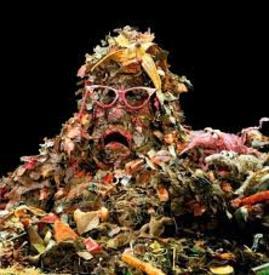How and why to use a digital food scale
Replies
-
Such useful information! Thank you!0
-
Maybe you live in Brobdingnag (Gulliver's land of the giants), and your idea of a "small" apple is what the nutrition label guy calls, "OMG! What IS that thing?"
Literally laughed out loud when I read this. You have a gift for comedic writing. Anyway, thank you so much for this! I already knew most of it, but I can see how it'll be very helpful for those who don't. Thank you! :flowerforyou:0 -
My weight loss really kick started into high gear after I got my food scale. I only paid $18 at Walmart and it weighs in grams, ounces, and has a tare button as well. Its really opened my eyes to how much/little you can eat when you are guesstimating.2
-
The supermarket weighs the meats I buy. I just go by their numbers and adjust from kg to grams. No food scale needed. I think food scales are useful when youre the type of person that buys meat in bulk and preps their weekly meals in tupperware (like a bodybuilder would) then weighing would make more sense.0
-
The supermarket weighs the meats I buy. I just go by their numbers and adjust from kg to grams. No food scale needed. I think food scales are useful when youre the type of person that buys meat in bulk and preps their weekly meals in tupperware (like a bodybuilder would) then weighing would make more sense.
Meat's the only thing you eat? The food scale helped me both ways. In some cases I could stand to eat a bit less, in other cases more. But I think this is a creative spin on things. Basically the butcher already weighed it for you and you log the whole batch by weight? Nice0 -
I use a 6$ mechanical food scale from target. it has a TARE capability using a knob to dial back to 0 to account for a containers weight. it shows grams and ounces. I also use a mechanical body scale. I've learned from experience that when my digital things run out of power getting a new battery is a headache.0
-
Very helpful. Thanks for posting.0
-
Negative grams! That's genius! I did not think of that!0
-
Bump so I can read when I get a chance.0
-
I
 my food scale 1
my food scale 1 -
I'm just bumping useful old posts.0
-
i definitely need a food scale in my life!0
-
For anyone that doesn't have a scale with the capacity to weigh the entire meal before/after its prepared....just a suggestion... Place it as one serving when you do the recipe builder and then measure out the amount you (and others) consume either in measuring cups or weight (however you choose). Then measure whatever you place as leftovers, add the measurements and you now know the entire weight or measurement of the recipe and can divide/add to food diary accordingly.
For example: If I make I taco chili...My first step is to build the recipe in the recipe builder and place it as one serving. Then I measure out our portions. Say my partner will eat 10oz, I eat 10oz, and my son eats 5oz. Then as I place the rest into Tupperware for leftovers I'll measure that. Let's say it's 75oz. Then add it all up, our recipe made 100oz. And then i'll divide that into whatever oz servings I choose. Example 10oz equals one serving. Ill correct the recipe to say my taco chili made 10 servings (10oz x10 servings=100 oz) and add the serving to my log.0 -
Oh and for things such as apple or anything similar, I weigh my apple, eat what I want, then weight the leftover core.
Example the gala apple I just ate was 233 grams total. Afterwards, the core was 63 grams. So subtract the final from the beginning and I'm adding 170 gram gala apple to my log.2 -
My digital scale cost less than £10 and works a treat...and its just common sense how to use it!0
-
There are some great tips in this thread. Thanks OP!0
-
I would recommed weighing even some of the prepackaged things as well. I have had some Quest bars that were off by several grams either way. If there is a specific gram weight on the package, make sure what you have in the package equals that. You may be getting more or less than you think.0
-
When I want to weigh peanut butter, I put the plate with the bread on it onto the scale and tare. Then I pick up the piece of bread and spread however much peanut butter I want on it, set it back on the plate and read the number. I may add more if I haven't hit the amount I was planning, or scrape some off if too much.
Setting the jar on the scale and reading the negative number after taking some out is a good way, too. I do it that way for ketchup or salad dressing.
To get the number of servings for logging, divide the weight of the food by the weight of the serving size. So if a serving of peanut butter is 32 grams and I am eating 20 grams, then I log 20/32 = 0.625 servings.0 -
this was waaaaaaaay to long for me to read it (I scanned it through).. I have been using a scale for a really long time and since I know it well, would be good for newbies to MFP and those not using a scale now..
I think this should be shortened a wee bit and put into the sticky sections... Maybe give those on a budget other options from 10.00 to 20.00 buck scales.. I bought my Ozeri (black) for 20.00 bucks (I do not need to weigh anything over 10 lbs).0 -
Yea ok,very good, but most food here comes with a calorie count on the label. This is an E U legal requirement. This is not present in the U S ....?0
-
-
Yea ok,very good, but most food here comes with a calorie count on the label. This is an E U legal requirement. This is not present in the U S ....?
Do you buy everything you eat in single-serve packages? If you're not eating the whole package, you need to know how much you are eating. Plus, what about fresh veggies and fruits? They don't generally come with nutrition labels (in the U.S., anyway), unless it's something packaged like bagged spinach or salad.2 -

Bump0 -
I weigh everything. Even the salad dressing. I put the bowl with my salad on the scale, zero it out, and then pour the salad dressing, and stop at whatever amount of serving I think is ok to eat.
Meat, cheese, fruit, vegetables, pretty much everything.
I use measuring cups for all liquids.
We make lots of small errors here and there I'm sure, but this at least reduces the possibility of being way off on how much I eat.0 -
i have the same scale as OP and like it.
however, i got mine (still new in packaging) for $15 off a local buy/sell group LOL1 -
 0
0 -
Nothing to see here. Just bumping old but useful posts.
 2
2 -
Don't mind me. I just like bumping useful old posts.1
-
Outstanding post, thank you.0
-
I'm no expert, but I've finally made peace (or at least an uneasy truce) with weighing my food. Along the way, I've found a couple of tricks to help make it easier and, since I like to write, why not share? Anyway, here goes.
First of all, if you don't have one, buy a digital food scale. Just do it. If you're trying to lose weight, you NEED one. Trust me. Here's the URL to the one I have (because I'm too lazy to make it a real link):
http://www.amazon.com/OXO-Grips-Stainless-Pull-Out-Display/dp/B000WJMTNA/ref=sr_1_1?ie=UTF8&qid=1400334102&sr=8-1&keywords=oxo+digital+scale
That particular model costs ~$50, which isn't pocket change for most of us, but I believe it's the most important and essential tool in your arsenal when you're trying to lose weight. (The other, in my opinion, is a heart rate monitor--but that's another topic.)
Of course, you don't need to buy the same kind I have. Buy whichever one you like. If a pink or purple food scale will make you like it more (or hate it less), get that! Just read the reviews and make sure it's accurate and, whichever one you buy, it must have two features: The option to weigh in GRAMS, and a "ZERO" or "TARE" function.
Grams are important because, if you look at a food label (which you should be doing, right?), you'll notice that they'll always put a serving size with an arbitrary measurement--3 pieces, 1 scoop, 1/12 cake, 1/2 cup, one rounded tablespoon, and so forth--followed by a weight in grams. The weight in grams is required by the food label police because pieces, scoops, slices, measuring spoons, etc., are ridiculously arbitrary for solid foods. Pieces vary in size. Chunks break off. You can mash food down or let it stick out the top of a measuring cup. Your idea of a "rounded" spoonful or a "full" cup and mine may be totally different from what the label guy had in mind. Grams, however, don't lie. They are what they are, no matter how you stack them. They are the best and often the ONLY way to make sure you have an actual "serving" of food, and not 1.16 or .89 servings. You can even weigh those tortilla chip crumbs at the bottom of the bag that you tell yourself "don't count." Unfortunately, they do have a weight--and they do count.
Once, you've got your scale, how should you use it? This may sound obvious, but some people need to read it: Weigh everything you're about to eat, unless 1) It's a liquid (you should usually use measuring cups for liquids), or 2) It comes prepackaged and pre-measured in a single-serving container. Notice I said "pre-measured," so fruit is NOT EXEMPT. Think about it: Do you really know what a "small" apple is? A "medium" banana? A "large" baked potato? Don't trust your eyes to tell you; if yours are like mine, they're lying cheats. Maybe you live in Brobdingnag (Gulliver's land of the giants), and your idea of a "small" apple is what the nutrition label guy calls, "OMG! What IS that thing?" It takes about ten seconds to find out for sure and, if you're on a tight calorie deficit budget like I am, you should try to be as accurate as possible. Otherwise, "Why am I not losing weight?" Been there, done that.
The "tare" or "zero" button is something I just couldn't live without. It's bad enough having to keep a scale near my food; if I also had to have a notebook, pencil and calculator on hand, forget it. Oh, wait. Sometimes I do that. *sigh.* Anyway, what does "tare" mean? Here's from Wikipedia. "Tare weight /ˈtɛər/, sometimes called unladen weight, is the weight of an empty vehicle or container. By subtracting it from the gross weight (laden weight), the weight of the goods carried (the net weight) may be determined." In other words, it can be used to subtract the weight of your plate from the weight of your plate + food. Here's how that works.
Let's say you want to eat a serving of spaghetti and meat sauce. Who doesn't? You've been good and read the label (or looked it up online if the label was unclear) and found out that a "serving" of cooked spaghetti is 1 cup (140 g). Now, spaghetti is a perfect example of how difficult it is to use a measuring cup for a solid food. How the heck are you supposed to get an accurate "cup" of spaghetti? My mushy spaghetti will settle into the cup like it's found its forever home. My husband's chewy spaghetti will be desperately trying to escape, like it knows what's coming next and wants no part of it. Spare yourself the drama!
Put your scale on a flat, stable surface. Turn it on and wait for the display to settle. If it's reading anything but 0, tap the "zero" or "tare" button. (I'll just call it the "zero" button from now on to save time.)
Now that you've made sure the scale is reading "0" when nothing is on it, weigh the plate you plan to eat from. Make sure your scale is displaying grams (mine has a button to switch from lbs to grams). It's a good idea to notice the weight of the empty plate, just in case the scale turns itself off before you're finished weighing stuff. (Mine has an auto-off function that sometimes triggers before I'm done weighing--which is the only thing I *don't* like about it, though it does save batteries when I forget to turn it off manually.)
Once you've weighed your empty plate, tap the zero button. Now your scale is "zeroed" (tared) for the weight of the plate. Take the plate to the spaghetti bowl and let your lying eyes guide you as you wrangle a "serving" of spaghetti onto the plate. Bring the laden plate back to the scale and weigh it. The weight you see is for JUST the spaghetti. How close did you get to one serving? Take off or add spaghetti as appropriate until you're right at 140 g. You can use a measuring cup to dish a serving of meat sauce onto your spaghetti, or weigh it too, if you know the weight of a serving (I'll write about that in a minute).
It occurs to me as I"m typing this that "guessing" a serving, then weighing to see how accurate you were, might be a way to gradually "train" yourself to better estimate serving sizes--but, having regained nearly all my lost weight using the 'eyeballing' method, I doubt I'll ever trust myself that much again.
Anyway, back to your spaghetti dinner. What if you're going to eat another weighable food along with the spaghetti and meat sauce? Zero the scale and add the next food to the plate. Now you're weighing just the new food, all by itself. It's almost like magic! *ahem* It's science magic.
What if you're making a recipe? You can weigh/measure each ingredient separately, or use the scale to weigh each item as you add it to a mixing bowl, not forgetting to zero out after each new addition. Unless I'm sure I can get it all weighed quickly, I usually weigh each item separately as I go because of that auto-off feature I griped about before.
Oh, and here's another way your scale can help you! (And this is a good argument for buying a scale with a higher weight limit than you think you might need.) Let's say you're making a nice pot of homemade chili. The recipe says it makes 8 servings. (By the way, check out MFP's recipe builder if you haven't already. It will total the calories per serving of your recipe for you.) But exactly how much IS a serving? By the time you've added chopped veggies, liquids, accounted for evaporation (?), and so on and so forth,how can you tell how much 1/8th of the pot is, without the dreaded guesstimation?
Before you even start cooking, weigh the pot you're going to cook the chili in. Write down its weight. Add all the ingredients, cook your chili, then (carefully--it's hot!!!) weigh the full pot of chili. Now, one thing life has taught me is to avoid math at all costs, but sometimes you need it. Don't you hate when teachers are right? Subtract the empty pot's weight from the weight of the pot filled with chili. That's the weight of your entire recipe of chili. Divide by eight. (You have a calculator on your computer, btw.) That's the weight of one serving of a chili recipe that makes "8 servings." Voila! And it's also an example of when you might use a scale instead of a cup to measure a liquid(y) food.
What if you forgot to weigh the pot, didn't write it down, or ate the scrap of paper you wrote it on? All is not lost. Weigh the pot full of chili. Ladle your chili into an attractive serving tureen. You were going to do that anyway, right? ;-) Now wash out the empty pot. Don't rush, you have plenty of time--that chili will still be piping hot when our sun turns to a cold black cinder. Weigh the empty pot and subtract it from what it weighed when it was filled with chili. Divide the result by 8 with your handy calculator. That's the weight of a serving. Now you know exactly how much chili you can has.
That's all I've got. I still don't love weighing my food, and I guess I never will, but I do love my food scale. That other scale in the bathroom? Not so much.
If anyone has more tips for using the food scale to make life easier, or doing things better, faster, easier or smarter than I do, please post them. I'm still learning, too.
I weight my liquids on the scale in ml.
That's one thing I hate about the database most things are in oz and even then a UK oz is different to an USA oz. Am I missing something is there a way to filter out oz entry's? Saying that I don't use many liquids.
0
This discussion has been closed.
Categories
- All Categories
- 1.4M Health, Wellness and Goals
- 398.1K Introduce Yourself
- 44.7K Getting Started
- 261K Health and Weight Loss
- 176.4K Food and Nutrition
- 47.7K Recipes
- 233K Fitness and Exercise
- 462 Sleep, Mindfulness and Overall Wellness
- 6.5K Goal: Maintaining Weight
- 8.7K Goal: Gaining Weight and Body Building
- 153.5K Motivation and Support
- 8.4K Challenges
- 1.4K Debate Club
- 96.5K Chit-Chat
- 2.6K Fun and Games
- 4.8K MyFitnessPal Information
- 18 News and Announcements
- 21 MyFitnessPal Academy
- 1.5K Feature Suggestions and Ideas
- 3.2K MyFitnessPal Tech Support Questions
























